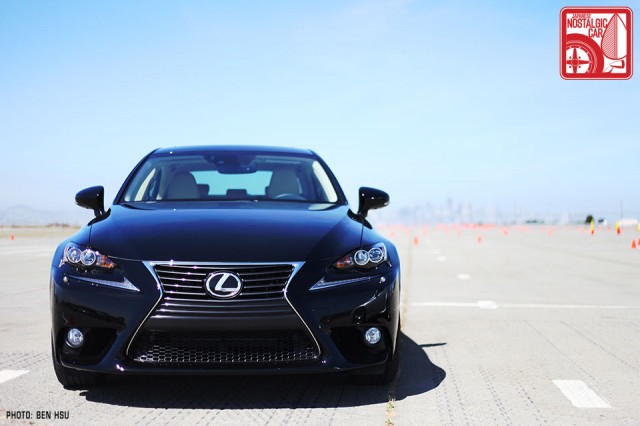
By the time Nobuaki Katayama began work on the original Lexus IS, he was already a rock star within Toyota. He’d chief engineered all-time greats like the Lexus SC and JZA80 Supra and, in his younger days, worked on the legendary AE86. He’d put in five years in the trenches of Toyota’s European motorsports program and in his spare time, according to company lore, was often seen behind the wheel, tail out, on rally stages.
As the so-called enthusiast’s Lexus, the IS 300 had a lot of weight to shoulder. The world was waiting for the still-young brand to prove it wasn’t just a wannabe. You see, Lexus wasn’t just the flagship marque for Toyota. It was, and still is, the flagship marque for all of Japan. With the third-gen IS dropping worldwide, it’s time to look back on Katayama’s legacy, and see whether the latest incarnation is a worthy successor.

In all other Lexus models, the letter “S” stands for “sedan” — Executive, Grand, and Luxury. The IS 300 was supposed to change that into “sport.” Lexus was a reliable, unobtrusive butler capable of balancing a pyramid of wine glasses with grace. What it wanted to be was a rambunctious street fighter capable of dethroning the ultimate driving machine. Enter the “Intelligent Sport.”
We at JNC have always liked the IS 300. We remember fondly how it came out with guns blazing to challenge the status quo. We dug its sprightly handling, engaging driving experience and purposeful looks. In fact, we like it so much that photographer Dan Hsu bought a used one recently. Other pundits rated its handling as better than its German rivals too, but it still failed to live up to its promise for two maddening reasons.
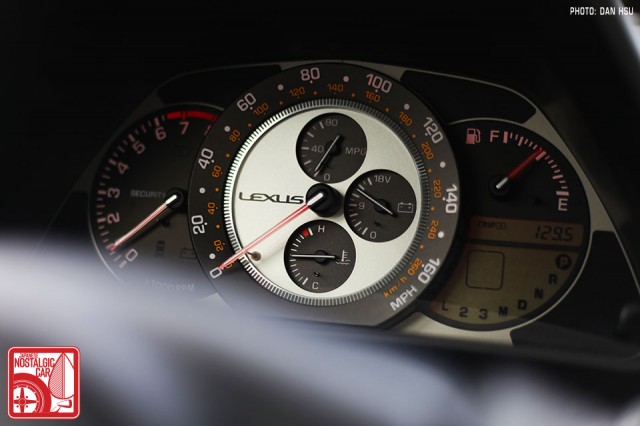
The first was Toyota’s own damn fault, and as plain as the PRNDL on the IS’s chronograph gauges. Though it was eventually offered, the lack of a stick at its initial public offering was an epic misstep. Establishment players were looking — itching — for a reason to make the new kid sit at a different table, and Lexus served it right up to them on a silver platter.
The second reason was beyond Lexus’s control but no less fatal. At the time of the IS’s launch in 2001, the brand was a mere 11 years old, an embryo in terms of old world luxury. The customers it was courting wanted their insignias dripping with upper crust prestige, and the oval L— a logo basically made up because Americans wouldn’t shell out $40,000 for a Toyota— lacked that provenance.
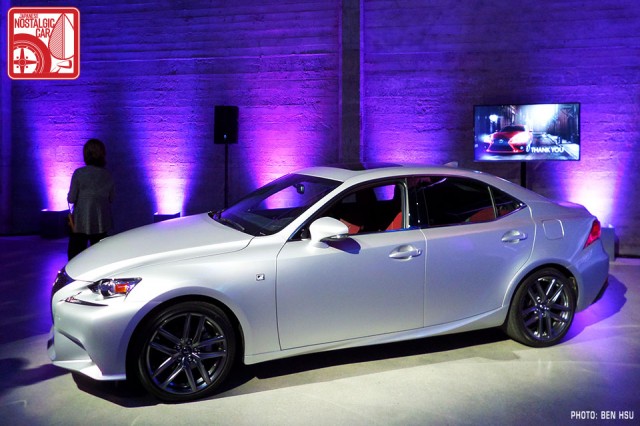
With the IS 300 losing out in the death-octagon of the free market, Lexus retreated to the comfort of what they know best. Its second-gen replacement grew roomier, quieter and more luxurious. For the cynical enthusiast, that’s code for bloated, less engaging, and heavier. It was, however, by most measures a better car, a focus group’s wet dream, and Lexus sold oodles of them during an economy booming on triple-financed houses.
Lexus recently invited JNC to San Francisco for an opportunity to assess the 2014 IS, the culmination of a years-long effort to unify the entire Lexus lineup under a common theme. Additionally, with Lexus just one year from its 25-year threshold into classic-dom, it’s important to gauge where Japan’s flagship marque is headed.

The key visual feature uniting all Lexus cars is now the “spindle” grille. Say what you will about the corporate face, but it’s a necessary part of brand identity. The unwashed masses barely know a Camry from a canoe, so the grille serves as a quick way to distinguish your deluxe chariot and tie the brand together.
It’s also a way to set different trim levels apart. The gorgeously formed diamond waterfall is exclusive to performance-grade F-Sports, whereas regular ISes get good ol’ horizontal bars (see lead photo). As its name implies, the grille is meant to evoke the spindles on Sakichi Toyoda‘s automatic loom, the invention that spawned the Toyota manufacturing empire.
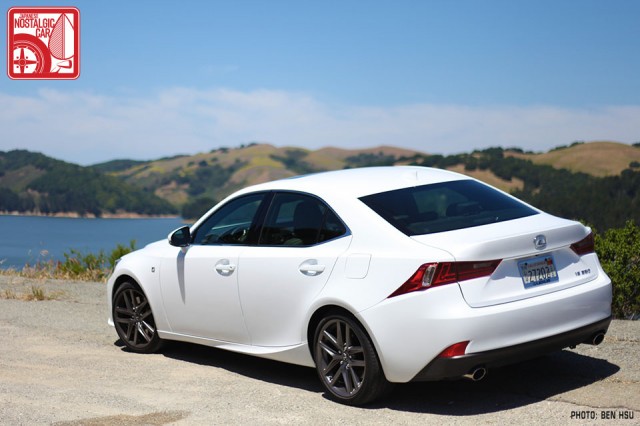
The only problem with corporate identities is that you have to keep them around for them to mean anything. Remember when Lexus made a huge hullabaloo over the arrow-shaped chrome on the 2007 LS 460’s C-pillars? There was even a whole commercial specifically about that one design trait.
But where is it now? It didn’t appear on any other Lexus and was never mentioned again. Toyota managed to duplicate the Nozaki Arc for the Scion FR-S, and you can see it in the new IS’s C-pillar too. We hope they stick with it. On the other hand, its katana-slice taillights and 1970s Nissan Skyline-esque “surf line” are certainly striking, but will take some getting used to for traditionalists like us.

Before you call us curmudgeons though, let us say that the F-Sport’s 3D gauges are absolutely brilliant. It simultaneously invokes the original IS 300’s chronograph and the trademark centerpiece on Lexus’s half-million-dollar LFA supercar. The steel-bezel even slides over to display auxiliary info like fuel economy, just like the LFA’s. Unlike the seemingly arbitrary Nike swoosh daytime running lights, it’s an ingenious way to tie the marque together.
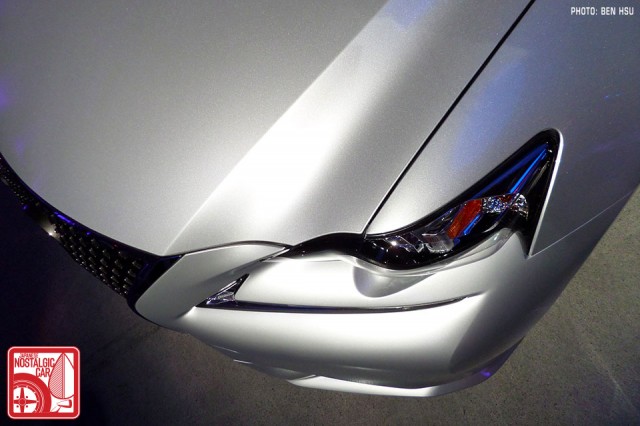
In addition to artful grilles and trick tachometers, the F-Sport package comes with a more aggressive fascia, fatter seat bolsters and a stiffer suspension. Why it’s even offered on the IS 250 is anyone’s guess. Enthusiasts will definitely want the extra 102 horses that come with the 306hp 3.5-liter V6 on the IS 350 (unlike ze Germans, model numbers still correspond to engine size).
There’s not much else that can be said about the 250 except that it no longer comes with a manual transmission. Neither does the 350 for that matter, but at least the latter is equipped (on non-AWD versions) with the superb 8-speed automatic from the outgoing IS-F. So is the lack of a manual once again a big fat fail? Actually, no.

Back when the original IS debuted, a modern car wasn’t that different from its nostalgic counterparts. Maybe an IS 300 would get you fuel injection, ABS and a CD player, but that was about it. Now cars have more electronic gizmos than all of NASA in 1985, and the automatic transmission is quicker shifting, better on fuel, and smarter than you.
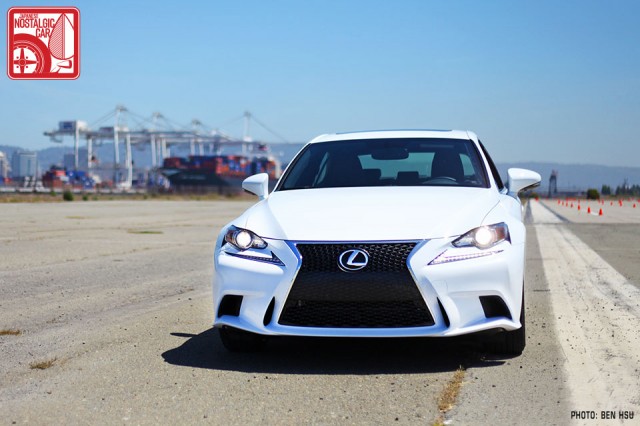
Launch the IS in Sport Mode and the trans clicks through to hyperspeed like a hummingbird’s wings. It’s nothing like the slushboxes of old where a shift sent shudders through the entire body. In fact, if Lexus didn’t pipe induction sound into the cabin a la Scion FR-S, you’d hardly know it was shifting. Throw the car into a turn and it’ll even hold the gear longer upon detecting sideways g forces. While you’re in that turn, you might even notice that its steering, unlike the outgoing IS, is not connected to the wheels by a dead fish.
Performance has improved over the second-gen IS by a country mile, even if it’s not quite as frolicky as the original IS 300. We loved the way Katayama’s baby bit into turns when you goosed the throttle, as if vestiges of the AE86 were echoing through. The new car is undeniably faster around an autocross course, but its weight and lack of a limited-slip diff hurt it in the corners.
The new IS can be fun car to drive, but only when it lets you do that, Dave. Here are just some of the things its Skynet ECU can do. It can slow down, follow by a pre-set car length and re-accelerate once the car in front has moved. It can measure the speed of the cross traffic behind it when you’re backing up. It can even predict what the traffic will be like 15, 30 and 45 minutes into the future.
We are one step away from the self-driving car, and the company that’s taking us there recently built a real-life Astro Boy and is sending it into space. With all this tech and power wrapped in an classically red leather cabin, one could hardly ask for any more, right?

There is only one criterium a new car needs to receive the JNC Seal of Approval: will it be coveted classic in 25 years? When the Katayama IS debuted, the answer was a no-brainer “yes.” Maybe it was the halo of the 2JZ, its trend-setting taillights or its timing at the peak of tuner fever. Maybe it was all those things plus its tight, RWD layout in a package the size of a 1998 Corolla.
This new IS? Well, it’s not a definite “no” but it’s not an unambiguous “yes” either. Lexus is in a very different place now. Toyotas are actually being considered classics so heritage is no longer a question, and Lexus has built a supercar to rival the world’s best. With nothing left to prove, Lexus doesn’t need to clobber us over the head with a does-everything brain the size of Deep Blue’s. We miss the upstart, can-do attitude of Katayama’s IS.
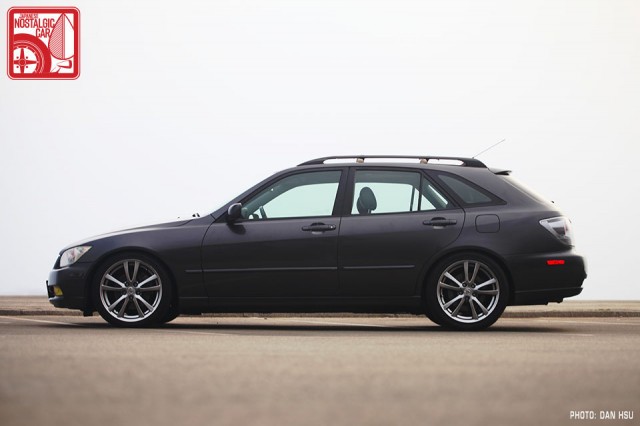
As for Dan, did we mention that he bought a SportCross? We’d like to claim it was because he needs the space for hauling around photography gear, but the truth is it’s just so damn cool. Naturally, it had to be Graphite Gray Pearl. Not only is it one of the best looking IS colors, but back in 2001 dark gray was rarely seen in the automotive universe. Now it’s practically mandatory on luxury cars and the IS set that trend.
Our search for a GGP SportCross nearly took us as far away as Atlanta and New York, but in the end craigslist came through with a SoCal local. Best of all, it was owned by a fellow JNC member (who goes by the usernameMaestro). Judging by the meticulous walkthrough he gave us and his gorgeous 240Z (which was already sporting a JNC decal!), we knew we were buying from a car guy who spoke our language.
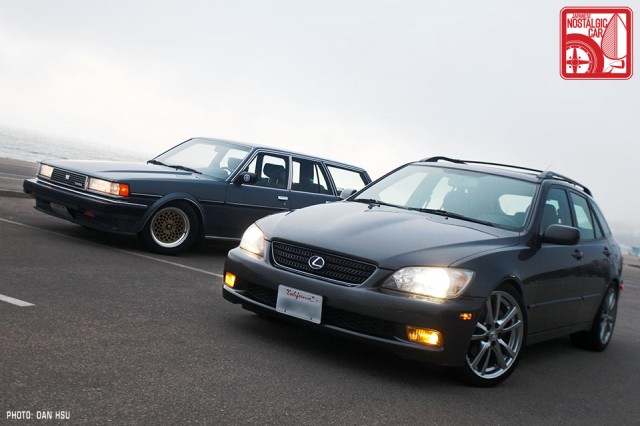
The SportCross makes the perfect companion to the existing JNC wagon, my 1986 Cressida. If we were in Japan, we’d instantly gain the nickname “Toyota Straight Six Brothers from Mt. Angeles!!” or something.
There are rumors the new IS will spawn coupe and wagon variants. If that proves true, it’ll edge closer to the definite yes category. For now, though, we’re glad to have the IS most imbued with Nobuaki Katayama’s spirit.
Interior images courtesy of Toyota.


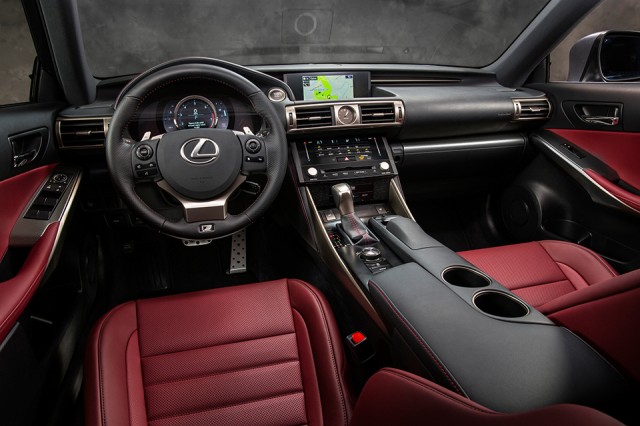




That console – ugh. If they’re going to not offer a manual, they could at least justify it by not completely filling the space between the front seats!
“There’s not much else that can be said about the 250 except that it no longer comes with a manual transmission.”
Lost all interest.
The styling is surely forward-thinking and I give them credit for pushing it through the beaurocracy, but I do have a bone to pick with those broken headlight graphics.
More nostalgics please- I do love the IS but I could go to Speedhunters for that type of stuff… I come here for the stuff no one else writes about.
I like the first generation best.
(“Heel toe down shiftable” and lighter).
Only If they offered a manual……..
Awesome read though I love how you guy at jnc recognize recognize future classics like this I can’t wait 25 years from now seeing all of these new cars
Let me offer a slightly different view on the original car. These “XE10” types were launched in Japan in ’98 as the Toyota Altezza, and its place in the market was a bit different. There were initially two models: AS200 w/ 2L inline-6 and RS200 w/ 2L inline-4. The RS200 engine was tuned by Yamaha, put out 210hp, was a little screamer, and was available with a 6-speed manual. Back then I was floored by these specs and immediately fell in love. In retrospect, the RS200 ‘Tezza was a nice reinterpretation of the small, light, RWD performance car in similar spirits as the AE86. The 2L inline-6 model was launched in Europe as the IS200 in ’98, but for some reason the RS200 was never sold outside of Japan. ~2 years later we got the IS300 w/ the 2JZ engine.
I think to most of us in the US, the IS300 was Toyota’s attempt at a 3-series competitor. For Lexus, that’s how they saw best to market the car and fill that niche, and that’s what it turned out to be. The platform itself, however, was more of a Toyota/Katayama interpretation of the small RWD sports sedan. It’s very Japanese and very distinctive, and the concept in its purest form is seen in the RS200. Measuring it solely as a 3-series clone, I think you actually miss out a lot on the car. When it finally came here as the IS300 with no high-revving inline-4 or 6-speed manual, I was a bit disappointed and felt it was watered down. I understood why they did it; it’s way more profitable to sell to men/women in suits than to boy racers. The newest IS seems to get some of that rambunctiousness back, and I like it quite a lot.
Oh and we have a SportCross and love it. Supposedly its origin story, and this may be apocryphal, was that Nobuaki Katayama and his son were into karting, and they wanted more room in the Altezza to carry gears. Hence a wagon was developed. We got ours ‘cuz we needed room for a new baby. My plan is when the wife and kid(s) move on to an even larger car, I’ll take it as my daily driver. Btw the roof rack on Dan’s car is curious. Lexus never offered it in the US; I’ve seen Japanese cars w/ roof rack, but it looks a bit different.
Dave, you are right on the money. That’s what I was hinting at with the “RWD package the size of a 1998 Corolla” statement. The 3S-GE Altezza is exactly a modern AE86 but with 2 extra doors.
The roof rack was installed by Maestro, the previous owner. He adapted a RAV 4 rack and it was mounted without any modification to the SportCross.
Let’s start a Sportcross meet. It’ll be you, me and a bunch of soccer moms who have no idea they’re driving one of the best cars in the world 😉
Yes let’s! It’ll be like all four of us. Every time I see another one on the road I’m always shocked. One time I saw one in the same color twice in the same week; that was a bit disconcerting.
RAV4 rack w/ no modification? That’s interesting, I may have to look into this for my car…
Just found out one of our designer friends at Mattel has one as well. SportCross party!
The IS300 is hardly a car worth praising, the JZX90 and JZX100 deserve much more attention.
Sounds like the new IS will be promising, wait until we see it in action. As for the cars at the end, they look EPIC the Cressida is sweet, and IS Sport Cross is very nice too, that color. :O
Thanks for the great write up. There are spy pictures of the two-door coupe floating around; I saw a disguised one on Miata.net. A part of me is glad that they do not plan to offer an M/T; I have an M/T IS300 (one of the last with the Torsen LSD!) and would be hard pressed to buy another IS. OTOH, Toyota did wait one year before bringing in M/T IS300s and I love two door coupes; maybe history will repeat itself?
I have forever longed to own the IS300. The cluster was a huge selling point for me back in 2004. But, the price wasn’t. Then last year to compliment my AE86 I picked a 2002 Intensa Blue Peal SportCross. It’s the perfect family. The daily is just as fun as the weekend car. Plus, with my strong belief the past dictates the future. Knowing the cars are linked is an awesome history piece to pass along at car shows.
One thing that should also be note worthy on here is the man Chuck Goldsborough. Yes, Team Lexus mastermind Chuck Goldsborough. I had the awesome opportunity to sit down and have a talk with him at his office on July 10th. Got the story of how he cold called Lexus to do a racing team. Bought a GS400, started winning races. (Lexus said if you fail we do not know you) Getting 4 IS300’s (from Lexus) and winning the 2002 Grand Am World Championship. (Which I got to hold the Drivers Championship Trophy) Mr. Katayama even came to see his outfit. Even the heartbreak of Lexus pulling the plug before entering 3 2nd gen IS’s into the ALMS. But, after that he still helped in the LFA and ISF projects. He gave me such knowledge no book could ever say. Plus, some rare posters, items never seen before, and even signed my Lexus book. Also, he called the current owner (Who was the crew chief of the team) of the Team Lexus SportCross a call to try to get a nice photo opt of my car next to it.
What I’m trying to say is yes Mr. Katayama did design the car but Goldsborough should be a worthy mention as well.